Lead nurturing 101: improve your lead nurture campaigns with these 6 strategies
- Fahad H

- Jan 22, 2019
- 8 min read
Between 40% and 60% of people who sign up for a free trial of your software will never convert. What are you doing with the leads that don’t convert right away? If your answer is “nothing,” you’re leaving money on the table.
By instituting a lead nurturing campaign sequence, you can guide those prospects through your buying cycle, from the moment they enter their email address on your website, to successful adoption of your product and beyond. To help you along the way, we’ve put together a step by step guide to getting your lead nurturing campaigns off the ground.
What is lead nurturing?
Lead nurturing refers to the automated process of taking a person from one step to the next in the buying cycle, automatically. The lead nurturing process generally involves communicating with people from the time they have a basic interest in your product to the point at which they are engaged enough to make a purchase decision.
Why lead nurture should be an important part of your marketing strategy
These days getting someone to hand over their email address is easy. The hard part is converting them into long-term, loyal customers. To do that, you need to nurture leads throughout their free trial. In the same way a gardener wouldn’t plant some seeds and abandon them to the elements, you need to constantly observe and adapt to your fledgling new signups before they wither and die.
“Every new signup will get the messages that are right for them”
Traditionally, this has been done with a series of scheduled messages. You set up a drip campaign, where a message is sent on day 1, day 7, day 14 etc. The problem? These one-size-fits-all message schedules treat all new signups as a homogenous blob and ignore how they’re actually using your product. For example, your schedule might make total sense for someone successfully advancing through the free trial, but ignores someone who logged in once and never came back. Fortunately there’s a better way.
At Intercom, we tackle this using behavior-based nurture messages, which adapt to the actions potential customers take during their free trial, at different times and in their own unique order. It means that every new signup will get the messages that are right for them, giving you the best chance of driving them towards conversion.
7 nurture messages you should be sending in 2019…
Below, we list six of the most effective lead nurturing messages we’ve used to nurture thousands of customers. Use them as inspiration for your own nurture campaigns to get new signups through those all important first few hurdles.
The welcome message
All of the data we have says that welcome messages are more likely to be read, clicked on, and responded to than any other message in your nurture campaign. In the same way a maître d sets the tone for your whole experience when you enter a high-end restaurant, a welcome message sets the tone for your product. Get it wrong, and it’s likely the whole experience will be ruined.
A welcome message also gives you a chance to dig deeper into what’s motivating new signups to use your product. You’ll quickly get a clear picture of the kinds of things new signups are trying to do which will help you understand how you can best get them there.
At the very least, new signups will know that they have a direct line to your sales and support team, and they’ll be less likely to quit if they hit a snag.
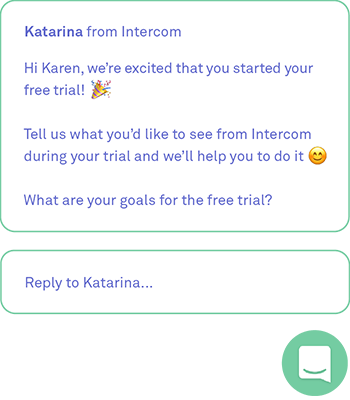
The abandoned signup message
There’s a common misconception that the sales process works like a chain reaction. See –> want –> install –> pay –> happily ever after. Life doesn’t work like that. You’re competing against the powerful forces of life, like distraction and busyness so your customers need a little nudge, if not outright persuasion.
Enter the abandoned signup email. If you’ve ever installed a product only to promptly close it and never look at it again, you’ve probably received an email like this. They’re great for reminding new signups to finish setting up your product so that they can start their march towards victory.
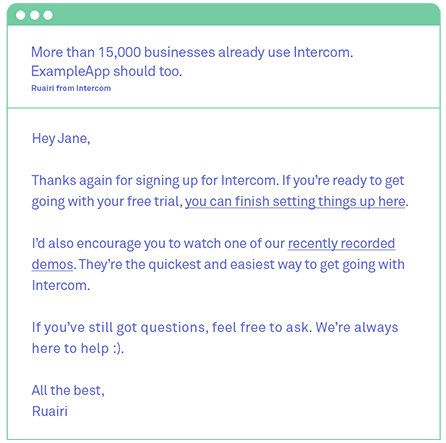
Pro-tip: Keep your subject line personal with company name variables and make sure you outline a clear next step – demo, webinar etc – so they’re less likely to abandon your product again.
The activation message
When someone signs for a free trial, it’s important to make sure they’re performing the high-value activities in your product as soon as possible. These “successful moments” will differ for every company, but here’s a very easy way to find yours.
Ask yourself, what does a successful customer look like? What are they doing in your product? Work backwards from that ideal customer, asking “How were they able to do that?”. Following these steps and you’ll identify the ultimate causes of success. That moment is what you need to activate.
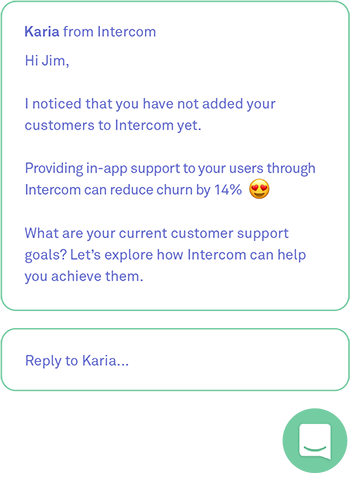
The milestone message
Your product should (hopefully) improve people’s lives in its own particular way. The next step is to define the bare bones milestones users must complete to begin experiencing that better life. If I bought a grill, it could be cooking up my first steak. In Slack’s case it could be inviting five teammates to the product.
“A timely in-app message is a positive feedback mechanism”
After defining these milestones, recognize how new signups are becoming that better version of themselves. A timely in-app message is a positive feedback mechanism that lets people know “Congrats! You’ve done X, Y, and Z. Now you’re three steps closer to why you signed up in the first place.” If customers feel like they’re making progress, they’re much more likely to go beyond the free trial.
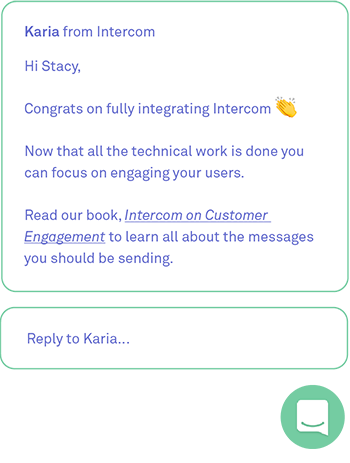
The social proof message
One of the best ways to nurture new signups towards success is by using stories from existing customers. Marketers call it social proof: when we see lots of others doing something, we assume that that’s the correct behavior.
The secret ingredient in messages such as this is being specific about the problem your product solved has solved for other companies, and the problem they’re facing too. Specificity about a problem, demonstrates to the reader not just that your product is generally good (that’s not enough), but that you can solve their problem. Touch that nerve, and your customers will quickly see how your product can work for people just like them.
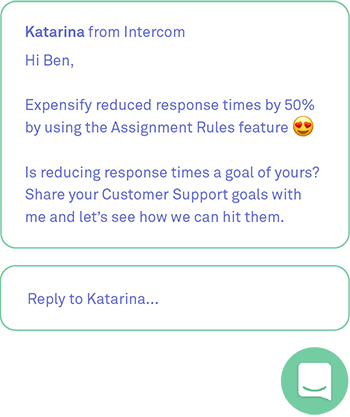
Pro-tip: To avoid annoying customers in your nurture campaign with too many messages in quick succession, you should specify how many days you’d like to leave between messages. We recommend selecting at least 2 days.
The end of trial message
People hate losing more than they love winning – and it turns out this very human tendency can impact the success of your business.
If you have a free trial for a SaaS product, the kind where an upgrade is required to continue, loss aversion naturally comes into play. You want to make sure new signups feel like they’re losing something of value, increase their desire to keep using it, and be willing to pay for the ability to do so. The trick is making sure your message convinces the user that life without your product is a step backwards.
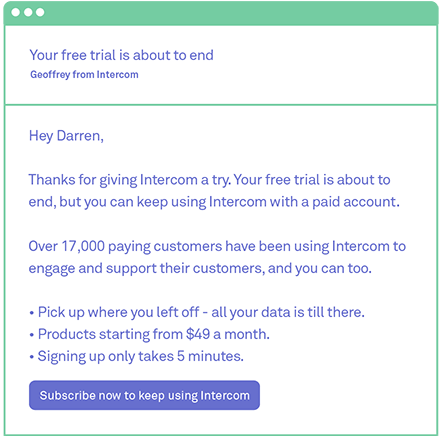
Pro-tip: If a user still hasn’t converted with just 2 days left on their trial, it’s a good time to offer them a discount (e.g. 25% off their first three months if they sign up today).
The win-back message
It’s a simple truth that not everyone will see the value of your product during the first few weeks. You’ll hear phrases like: “I couldn’t find the time to get my head around it” and “I didn’t see any immediate value.”
Identify recent signups customers who didn’t make it beyond the free trial and send them a well-timed, personal email to try re-engage them. The best case is that you recover a customer; the worst case is you learn why you users leave. Either of these leaves you in a better position than doing nothing.
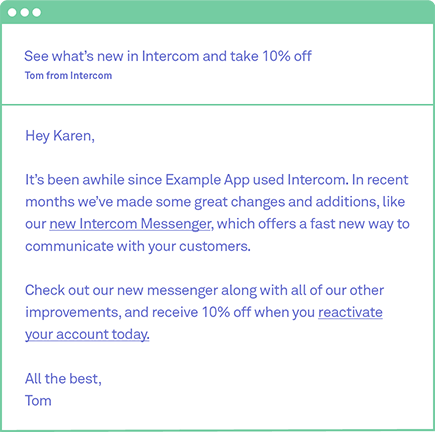
Pro-tip: Don’t assume lapsed signups will remember who you are. Remind them who you are, and motivate them to return with an email featuring some of the features added in the past 30 days, or a discount as an incentive to return.
And 6 strategies to improve your nurture campaigns
Your nurture campaign will only be successful provided your communicating with people using the right message, at the right time and in the right medium. Here are some items to consider as you’re building out your nurturing campaigns.
Target users based on time
To ensure you’re not over-messaging people, Space messages out and send them at specific time intervals. For example, you could send your first message to users who started a trial 2 days ago, the next to users who started a trial 10 days ago.
But target based on behavior too
Take what you know about when your users’ signed up and combine it with what they are doing in your product. That’s your recipe for success. For example, trigger messages based on actions (e.g hasn’t used feature X).
Avoid conflicting messages
Make sure two different groups of users don’t get the same message. You won’t want to send active users the same conversion message as users who are slipping away. (You can use “Received message X is false” in Intercom)
Use signals on other messages to send follow-ups
Use signals from the messages you’ve previously sent to determine which message is sent next. If people didn’t click on a link or didn’t open your last in-app, try sending them an email or push message to bring them into the product.
Keep it simple at first, add complexity gradually
Take it slow and build complexity into your nurturing campaign. It’s easy to get overwhelmed if you create the most sophisticated campaigns straight off the bat and try cover every potential use case. Start with a simple nurture campaign of 4-5 messages.
Message people in the right place
Trying to get people to complete the final stage of sign up? Use email marketing. Want to get someone to interact with a specific feature? Use in-app so it’s in context. Make sure you’re also messaging people at the right place in your app.
Measuring the success of your nurture campaign
A nurture campaign ends in one of two ways: The person who signed up for a free trial either converts along the way or makes it all the way to the end of the campaign and doesn’t. Those two scenarios are the only options the lead should have.
“Remember to remove people from the nurturing program after they have converted”
If a lead reaches your goal, he or she should be removed from the nurturing campaign. You can remove the lead through an automation rule, but if you’re using Intercom this is done automatically for you. Regardless of how you set up the removal of the lead from the program, just remember to remove people from the lead nurturing program after they have converted and are no longer in the sales funnel.
For leads who don’t convert along the way, you should deal with these leads in a very specific way, using one of the following basic techniques:
If the lead makes it to the end of the campaign, remove the person from the nurturing campaign but keep them in your database. You can then use this list as a holding pen, or as the beginning of another nurturing campaign.
If the lead is on a sales program, let the sales team know the lead has finished being nurtured. The sales rep can then decide what to do next with that qualified lead. The rep may want to reach out with a personal email or add the lead to another campaign. The point is to let the salesperson control the next step.
End with a nice note. You may want to have the last lead nurturing email in your nurturing program be a “break-up” email. This is a common practice for getting an engagement. Your email may read very much like he “end of trial” message above. The tactic is similar to what magazines do when they put “This is your last issue” on the cover of the last magazine in your subscription.
Start your nurture campaign today
There are many reasons people abandon free trials. Your product might not have been a good fit for them. Their actual experience of your product might not have matched your marketing/sales pitch. Or they might just have gotten busy or had their own priorities change.
However, people largely abandon free trials for reasons which are within your control: they did not see the value from interacting with your software. You can increase their chances of success by setting up a simple nurture campaign today. Thankfully, we’ve built a product to do exactly that. Head this way and start building your nurture campaign today.








Comments